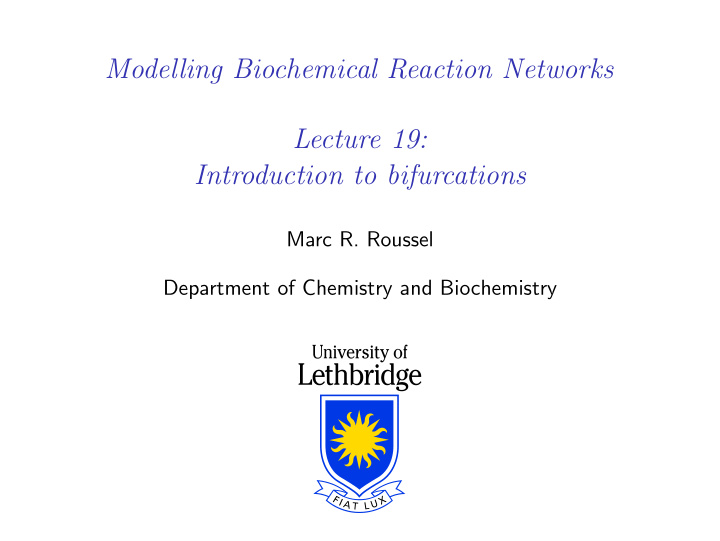



Modelling Biochemical Reaction Networks Lecture 19: Introduction to bifurcations Marc R. Roussel Department of Chemistry and Biochemistry
Recommended reading ◮ Fall, Marland, Wagner and Tyson, sections A.4 and A.5
Phase space ◮ Many biochemical models take the form of autonomous (no explicit dependence of right-hand side on time) ordinary differential equations. dx i dt = f i ( x ) , i = 1 , 2 , . . . n Phase space: space of independent variables ( x i ) of a system. The phase-space variables define the state of the system: knowing the coordinates of a system in phase space fully defines its future evolution. Analogy: Studying the trajectories of a system in phase space is analogous to looking at planetary orbits: There is an implied time dependence, but the shapes of the orbits can be described without talking about time.
Behavior near a steady state ◮ We can classify steady states according to the behavior of trajectories near these points in phase space. ◮ It is sufficient to look at steady states in a two-dimensional phase space (a.k.a. phase plane). Steady states in higher-dimensional spaces can be described in similar terms.
Classification of steady states Type Cartoon Stable node Unstable node Saddle point Stable focus Unstable focus
Local bifurcations ◮ A bifurcation is a qualitative change in the behavior of a model as parameters are changed. ◮ A local bifurcation involves changes in the number and/or types of steady states. ◮ Often illustrated using cartoons in which a filled dot ( • ) represents a stable steady state and an open circle ( ◦ ) represents an unstable steady state. ◮ Some of the simpler bifurcations can be observed in systems with a one-dimensional phase space. ◮ Any bifurcation that can occur in a d -dimensional phase space can also occur in a ( d + 1)-dimensional phase space.
Transcritical bifurcation x Before: At bifurcation: After: p represents a semi-stable point, in this case stable from the ◮ right and unstable from the left. ◮ In chemical (including biochemical) and ecological models, the immobile steady state is often at x = 0 (extinction/washout).
Saddle-node bifurcation x Before: At bifurcation: After: p ◮ In a two- or higher-dimensional phase space, the unstable point is a saddle, and the stable point is a node. ◮ The bistability studied in our two-variable model of the cell cycle is associated with a pair of saddle-node bifurcations.
Pitchfork bifurcation Supercritical x Before: At bifurcation: After: p ◮ This is another way to get bistability.
Pitchfork bifurcation Subcritical x Before: At bifurcation: After: p
Andronov-Hopf bifurcation Supercritical x min/max p ◮ Also known as a Hopf or Poincar´ e-Andronov-Hopf bifurcation. ◮ Creates a stable limit cycle (filled circles), an oscillatory solution of fixed amplitude and period (for fixed values of the parameters) reached from any initial conditions within its basin of attraction. ◮ The limit cycle has zero amplitude at the bifurcation and “grows out” of the steady state.
Andronov-Hopf bifurcation Subcritical x min/max p ◮ An unstable limit cycle (open circles) is created going backwards from the bifurcation value of the parameter. ◮ Going forwards, the system suddenly starts to oscillate with large amplitude. ◮ Occurs in our four-variable model of the cell cycle
Recommend
More recommend